New Thinking Was on Display at St. Louis Auto Show
In May 2008 I found myself car shopping. I could no longer ride my 90mpg scooter so I wanted a fuel efficient car. Gas prices had been climbing for months:
I was shopping for used a car but I found myself angered at the selection of new vehicles being offered:
Today Ford, GM and Chrysler are caught with too many trucks and SUV’s in showrooms as sales of these segments decline in the double digits. Toyota has passed Ford for the #2 sales position in the U.S. Honda is set to pass Chrysler for #3.
Why does it matter? Well the auto industry is an important part of our national economy. Many thousands of workers build the cars and many others work for suppliers to the industry. Until we can shift these people to other jobs a large part of the economy depends upon all of us doing our part and buying a new vehicle. But with the new reality of $4/gallon +/- gas consumers are finally rejecting trucks and SUVs. Frankly the U.S. economy is to reliant upon sales of autos and of new mostly suburban homes. (full post)
It wasn’t long before both GM & Chrysler were in bankruptcy and Ford was mortgaged to the roof and selling off brand after brand like Aston Martin & Volvo. All three were finally forced to rethink how the design, build and sell cars in a global economy. The government finally pushed the auto industry to higher standards:
The Corporate Average Fuel Economy (CAFE) mandate was first established in 1975 and until this past April 1 [2010] has changed little since. It’s been years of debate, but finally, the standards have been significantly updated. By model year 2016, the fuel efficiency of the new vehicle fleet sold in the United States will have to average at least 34.1 miles per gallon. [Popular Mechanics]
The fact is automakers had been making great improvements in efficiency for decades
Specifically, between 1980 and 2006, the average gas mileage of vehicles sold in the United States increased by slightly more than 15 percent — a relatively modest improvement. But during that time, Knittel has found, the average curb weight of those vehicles increased 26 percent, while their horsepower rose 107 percent. All factors being equal, fuel economy actually increased by 60 percent between 1980 and 2006, as Knittel shows in a new research paper, “Automobiles on Steroids,†just published in the American Economic Review (download PDF). [Source: MIT News]
If we still drove 1980 sized vehicles the automakers could exceed the 2016 CAFE requirement, per the above source. But with creative thinking and using technology used around the world the higher standard can be met:
The Hyundai brand has met the federal government’s Corporate Average Fuel Economy (CAFE) standards four years ahead of the 2016 deadline, achieving an average of 36 mpg across its model lineup, according to WardsAuto. But there are some who have taken issue with the EPA’s estimates of Hyundai vehicles, and have petitioned for a re-test of the 40- highway-mpg Elantra. Hyundai America CEO John Krafcik stands behind the Elantra’s mpg rating, however, saying the numbers are achievable in the real world. [Source: Motor Trend]
At the St. Louis Auto Show last week, new more efficient vehicles were on display. Click the image to see the official website for each vehicle.
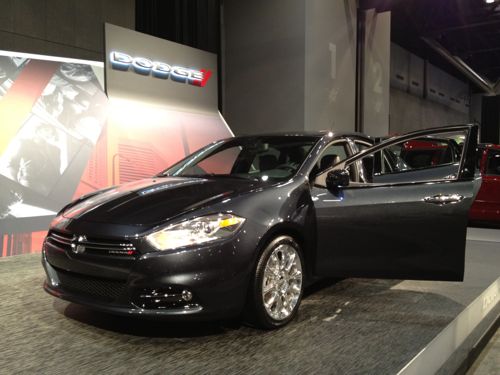
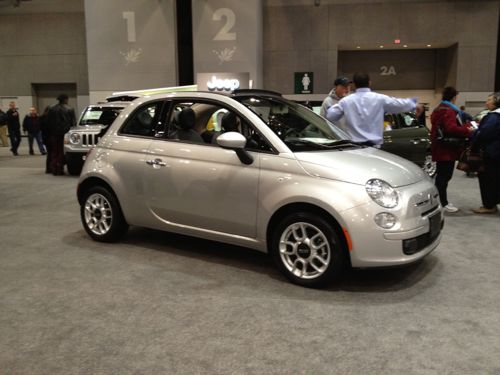
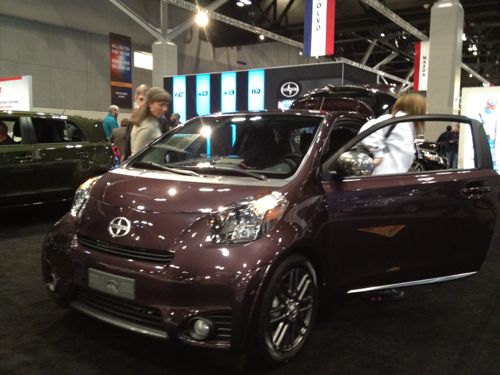
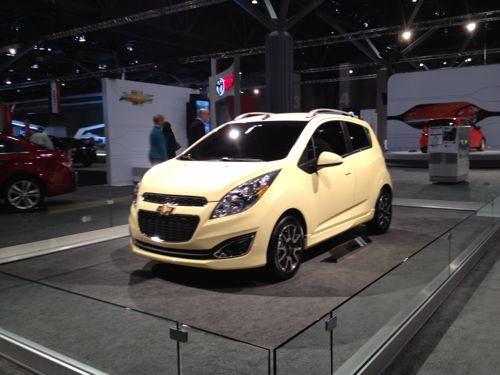
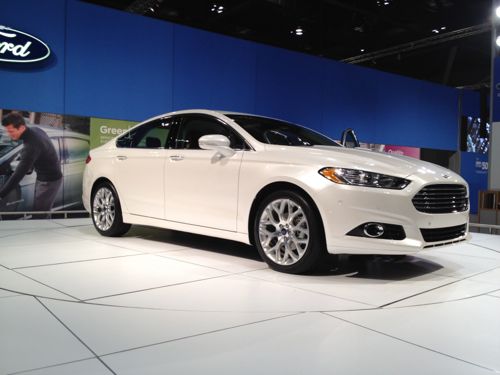
For decades companies like Ford built models specifically for the U.S. market that had no resemblance to European models. This increased development costs and gave U.S. consumers subpar vehicles. Those days are gone.
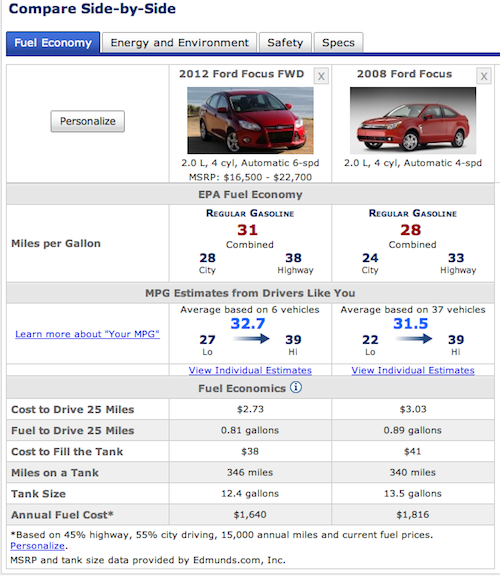
The 2012 Ford Focus is a global Ford, whereas the 2008 Ford Focus had nothing to do with European models. The gains in fuel economy speak for themselves. Over at GM a similar story is told.
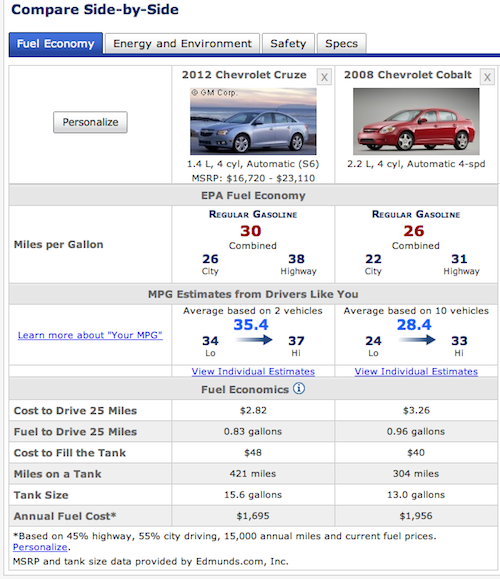
Chevrolet made strong gains with the Cruze that replaced the Cobalt.
President Obama has proposed a CAFE standard of 54.5mpg by 2025, coinciding with new regulations in California:
The Environmental Protection Agency and the National Highway Traffic Safety Administration have estimated that the improved technology would add $2,030 to the average vehicle purchase price, but that lifetime cost savings for fuel would exceed $6,000, for a net savings of more than $4,000 over the life of a new vehicle. The NADA disagrees with those figures and plans to release its own study next month that estimates a total price increase per vehicle of up to $5,000. [MSN]
With the economy rebounding fuel prices are expected to reach $4/gallon this summer. This time automakers will have vehicles that meet buyer expectations. When I’m ready to buy my next used car I’ll have better choices  than I had in 2008.
– Steve Patterson
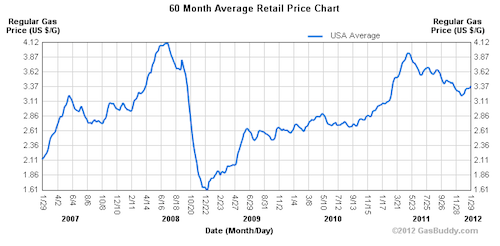
The flaw in your thinking is that new car buyers are as into cutting-edge fuel efficiency and “urban-small” as you are. The new Fiats are off to a disappointing start, selling less than a quarter of what they had expected/hoped in their first year back here. Chevy Volt sales aren’t meeting GM’s expectations, and the biggest selling vehicle remains the Ford F-150 pickup truck. Your used car choices will be driven by what sells, not what’s offered by the dealers. If you really want to shift the paradigm, you and many others need to start buying smaller NEW vehicles, and not waiting for them to filter down to the used market. So while fuel efficiency will continue to slowly rise, I don’t expect much of a shift to smaller vehicles by most buyers.
A related issue is the cost of insurance. A report out today has city residents paying 50% more for the same coverage as county residents – http://www.post-gazette.com/pg/12031/1207066-28-0.stm
The flaw in your thinking is that new car buyers are as into cutting-edge fuel efficiency and “urban-small” as you are. The new Fiats are off to a disappointing start, selling less than a quarter of what they had expected/hoped in their first year back here. Chevy Volt sales aren’t meeting GM’s expectations, and the biggest selling vehicle remains the Ford F-150 pickup truck. Your used car choices will be driven by what sells, not what’s offered by the dealers. If you really want to shift the paradigm, you and many others need to start buying smaller NEW vehicles, and not waiting for them to filter down to the used market. So while fuel efficiency will continue to slowly rise, I don’t expect much of a shift to smaller vehicles by most buyers.
A related issue is the cost of insurance. A report out today has city residents paying 50% more for the same coverage as county residents – http://www.post-gazette.com/pg/12031/1207066-28-0.stm
No flaw, I just didn’t mention that Gen Y buyers are into cutting-edge technology as me, a Gen Xer: http://www.latimes.com/business/money/la-fi-mo-gen-y-auto-sales-20120118,0,2659409.story
No flaw, I just didn’t mention that Gen Y buyers are into cutting-edge technology as me, a Gen Xer: http://www.latimes.com/business/money/la-fi-mo-gen-y-auto-sales-20120118,0,2659409.story
For me as a city resident, living and working in the city, fuel efficiency is not the most important factor when purchasing a new automobile.  Sure it’s nice for the half dozen road trips we might do in a year….but 15mpg v/s 25mpg doesn’t really effect the monthly budget much when it’s less than 3 miles to work.  Instead function, reliability and style trump MPGs (yet another reason, in the long list of reasons, to live in the city).  STL is also so vehicular centric that unless you’re driving something larger than a Suburban automobile size is unlikely to pose a convenience problem for you.
I think the biggest issues with these very small cars like the IQ, Four-Two and the 500 are that for the same money you can buy a much better, more usable, and larger car like a Mazda 3, Versa, Civic, Cruz or Focus and that the size increase does not pose any maneuverability or MPG penalties in your average American city.
For me as a city resident, living and working in the city, fuel efficiency is not the most important factor when purchasing a new automobile. Sure it’s nice for the half dozen road trips we might do in a year….but 15mpg v/s 25mpg doesn’t really effect the monthly budget much when it’s less than 3 miles to work. Instead function, reliability and style trump MPGs (yet another reason, in the long list of reasons, to live in the city). STL is also so vehicular centric that unless you’re driving something larger than a Suburban automobile size is unlikely to pose a convenience problem for you.
I think the biggest issues with these very small cars like the IQ, Four-Two and the 500 are that for the same money you can buy a much better, more usable, and larger car like a Mazda 3, Versa, Civic, Cruz or Focus and that the size increase does not pose any maneuverability or MPG penalties in your average American city.
I’d be embarrassed to be seen in that Chevy Spark.Â
I’d be embarrassed to be seen in that Chevy Spark.
My self worth isn’t tied to a vehicle.
Neither is mine. But I do have a sense of pride.
My self worth isn’t tied to a vehicle.
Neither is mine. But I do have a sense of pride.Â
I have two friends who recently purchased 2012 Toyota Corollas with 5 speed manuals, and they are averaging 41 MPG, city/hwy combined. I purchased a 2012Â Toyota Yaris hatchback with a 5 speed manual, and I am averaging 45.9 MPG, city/hwy combined. Neither car delivers a “high”, but it’s really nice to regularly drive past gas stations. And my Yaris is fun to drive.
I have two friends who recently purchased 2012 Toyota Corollas with 5 speed manuals, and they are averaging 41 MPG, city/hwy combined. I purchased a 2012 Toyota Yaris hatchback with a 5 speed manual, and I am averaging 45.9 MPG, city/hwy combined. Neither car delivers a “high”, but it’s really nice to regularly drive past gas stations. And my Yaris is fun to drive.
Really good article, I test drove a 2009 Yaris and felt every bump on the road so I went with a Camry. I really like those Nissan Leaf’s I test drove them at the auto show.
Really good article, I test drove a 2009 Yaris and felt every bump on the road so I went with a Camry. I really like those Nissan Leaf’s I test drove them at the auto show.